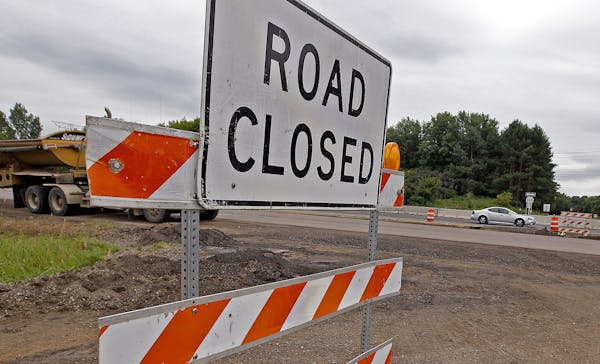Metro area drivers will find fewer construction zones to steer around this summer compared to recent years, but that doesn't mean there will be fewer hassles.
Work on portions of the state's busiest freeways — I-94 in both Minneapolis and St. Paul, I-694 in Arden Hills, and I-35W in south Minneapolis — not to mention the already up-and-running repairs along Hwy. 169 through Edina and Hopkins and Snelling Avenue by the State Fairgrounds will be more than enough to bring delays and traffic disruptions.
Getting out of town won't be pain-free either. A 6-mile resurfacing project on I-35 from the Forest Lake split to Hwy. 8 has the potential to spawn miles-long traffic jams while backups could form on I-35 in the Owatonna area where traffic will be single lane from April to November.
The slate of 211 road and bridge projects statewide totaling $1 billion may be the last robust round of road construction for years to come, Minnesota Department of Transportation Commissioner Charlie Zelle said during a news conference to officially kick off the 2017 construction season, even though many projects have already started.
When the new fiscal year kicks in July 1, "there are not sources to maintain a billion dollar program," Zelle said. "This is the period where we are winding down. We won't be seeing this kind of robust program in future years."
This year, MnDOT expects to complete the St. Croix River Crossing; the Hwy. 36 bridge connecting Oak Park Heights, Minn., and St. Joseph, Wis., and the long-discussed and long-delayed relocation of Hwy. 53 in Virginia, Minn., that includes the construction of what will be the tallest bridge in Minnesota.
Motorists have already felt the pinch on I-94 with lane reductions in place between 49th Avenue and Hwy. 55. Come May, the work zone will expand east to Nicollet Avenue and traffic will share one side of the Lowry Hill Tunnel until August. Lanes in the tube will shrink from 12 feet wide to 10 feet, and the speed limit will be reduced to 40 miles per hour.
Drivers on I-94 in the east metro are adjusting to a recently enacted new configuration. Between Century Avenue and Mounds Boulevard, westbound drivers are forced to choose a lane that will allow them to exit the freeway onto local streets or a lane that doesn't allow them to get off until they reach downtown St. Paul. On eastbound I-694 a third general purpose lane is being added between Lexington Avenue and Rice Street through Shoreview, Arden Hills and Little Canada.
Other projects already in progress or to start soon include pavement rehabilitation on Snelling Avenue between Como Avenue and Hwy. 36, interchange improvement and resurfacing of Hwy. 169 between I-394 and the Nine Mile Creek bridge in Edina and resurfacing projects that will close parts of Hwy. 110 through Mendota Heights and West St. Paul. South metro drivers could find it slow going as MnDOT replaces signs and repaves Hwy. 13 between Washburn Avenue and Hwy. 169 through Savage.
By late summer work should begin on the $240 million rebuilding of I-35W between Lake Street and the I-94 interchange. While freeway traffic won't feel the initial impacts, drivers will have to cope with the closure of the 5th Avenue ramps leading to northbound I-35W and eastbound I-94 and the ramp from westbound I-94 to 11th Street in downtown Minneapolis starting in August. The bigger disruption for I-35W drivers will be the three-month closure of the flyover bridge to westbound I-94, set to close when work in the Lowry Hill Tunnel begins in May.
MnDOT faces an $18 billion shortfall over the next 20 years due to flat revenue sources and rising costs. That means in future years, big ticket items will be fewer and farther between, meaning no funding for tacking projects such as rebuilding the I-35W and I-494 interchange, ranked as the 17th most congested in the nation, or rebuilding I-94 between Minneapolis and St. Paul.
"Our budget will see a 30 to 40 percent reduction in our capital program," Zelle said. "With more than half of our state roads older than 50 years, and 40 percent of our bridges more than 40 years old, the need is outpacing available resources. It's important that legislators work together to find a long-term, sustainable funding solution this year so the transportation system does not continue to degrade."
timharlow@startribune.com 612-673-7768

Records: Former Minneapolis police oversight head disparaged women, threatened staff
Video goes viral of man enduring 'shocking' chain whipping on downtown St. Paul street
Minnesota sales, clean-ups and other events to celebrate Earth Day and Arbor Day

Marijuana's path to legality in Minnesota: A timeline

